Guadix and the troglodyte caves - Granada Province
Granada - Andalucia - Southern Spain 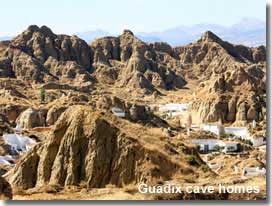
The western limits of Almeria province, from north to south, unite with the province of Granada, its only Andalucian neighbour. Not taking away from all the unique destinations and adventures that Almeria has to offer, if you are living or on holiday in Almeria it would be a shame not to take advantage of the closeness in locality to the special attractions that are situated just across the border.
Quick link - Guadix:
- Guadix pottery museum - Cueva Museo La Alcazaba
- Caves homes of Guadix - the Troglodyte caves
Choose Almeria - a guide to Guadix
Visit the Troglodyte caves and uncover the story of the man who changed the lives of the cave dwellers of Guadix...
Guadix
Guadix can be reached along the A-92 highway from Almeria to Granada, encompassed by rich fertile plains and set against a backdrop of a ridge of tawny coloured hills, 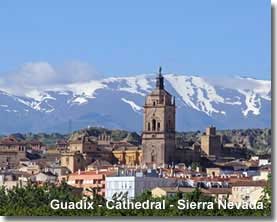 the dramatic heights of the Sierra Nevada mountain range are visible in the distance to the south of the town.
the dramatic heights of the Sierra Nevada mountain range are visible in the distance to the south of the town.
The town itself was established by the Romans as a mining settlement, silver being the mineral exploited from the hillsides. Yet it was under the Arab reign when the area really came into fruition, being a natural pass from the coast to the city of Granada, it rose to an important trading station protected by its hilltop Moorish fortress, the Alcazaba of Guadix. Now well past its glory days this Arab citadel presides over the town providing a spectacular view of the Barrio de las Cuevas, the cave quarter and main tourist attraction of Guadix. The Cathedral, built in the 16th century under the reign of the new Catholic Monarchs, makes an intriguing sight with its impressive minaret manifested as the church tower.
Guadix pottery museum
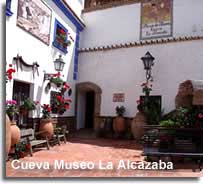 Nowadays Guadix is a thriving town with a bustling shopping centre and a well received much visited tourist destination. Though its main draw is the cave quarter and Alcazaba, the town is also well known for its ancient pottery.
Nowadays Guadix is a thriving town with a bustling shopping centre and a well received much visited tourist destination. Though its main draw is the cave quarter and Alcazaba, the town is also well known for its ancient pottery. 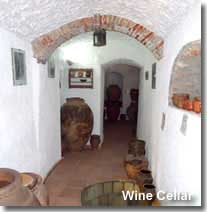
The Alcazaba pottery museum
Cueva Museo La Alcazaba
This pretty pottery museum and gift shop, located just behind the Alcazaba, consists of several interlinked cave rooms including a living area, bedroom, and wine cellar. Each is filled with traditional pottery, some dating as far back as the 17th century.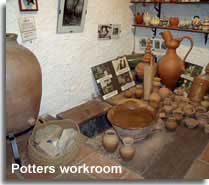
The potters workroom in the photo to the left shows the arrangement of the ground level potters wheel, sunken floor and potters seat. This cave room displays several old photos of the pottery makers at work along with a display of earthenware drinking jugs.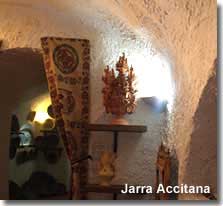
Examples of the ancient domestic and decorative pots, pitchers and drinking jugs on display in the museum include:
- Jarra Accitana - these decorative jars, given to the bride on her wedding day, are adorned with motifs such as cockerels and farm animals and have the family names inscribed into the handles, a lovely tradition that still continues in the present day.
- Figurines - representing time honoured professions such as carpenters, cobblers, bakers, water sellers... and of course pottery makers
- Canteens - used by farmers to carry water
- Fajalauza - multi use domestic and decorative platters
- Cuezo Arabe - Arabic water storage pots
- Jarras de Vino - wine jugs with examples dating from 1650 to 1950
- Tinaja - large earthenware jugs used to keep wine
- Botijas - earthenware drinking jugs of various shapes decorated with animal motifs
Even then the Spanish knew the importance of storing wine and water, a tradition that has never been lost!
Opening Times:
Every day - 10.30 to 14.00 and 16.30 to 19.30
Address: Calle San Miguel, 54, Guadix.
Guadix Caves
Barrio de las Cuevas
The cave homes of Guadix, or, Cuevas de Troglodyte, the troglodyte caves.
Troglodyte - a cave dweller
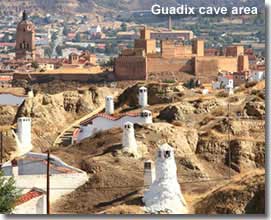 The name troglodyte, to me anyway, brings to mind a visual image of prehistoric man living in caves, when actually, today, Granada Province is said to have the largest cave dwelling population in Europe, and Guadix the highest concentration of inhabited caves in Spain.
The name troglodyte, to me anyway, brings to mind a visual image of prehistoric man living in caves, when actually, today, Granada Province is said to have the largest cave dwelling population in Europe, and Guadix the highest concentration of inhabited caves in Spain.
This intricate maze of homes is not fashioned from natural cavities, it is a man made phenomenon created by the act of human burrowing into the soft sandstone rocks. There is evidence of cave dwellings having existed in this area as far back as the Arab invasion of Iberia in the 8th century, though opinion suggests that the main labyrinth of homes were created in the 16th century and onwards when, after the successful Christian invasion of the region, the Moors, fearing persecution from 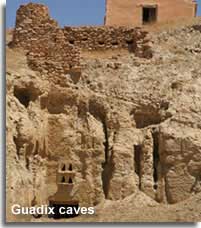 their conquerors, fled from the city into the hills.
their conquerors, fled from the city into the hills.
Remains of this type of habitation are also in existence in Almeria, particularly around the villages of Sante Fe de Mondujar, Alhabia, Gador, and Benahadux.
The cave district of Guadix is located behind Calle de San Miguel, it is speculated that there could easily be over ten thousand people living in these underground homes. Inside the caves a year round temperature of around twenty degrees Celsius is naturally maintained, while on the outside the summertime highs reach over forty degrees and the winters can frequently see snow.
Today the lower cave homes are thoroughly 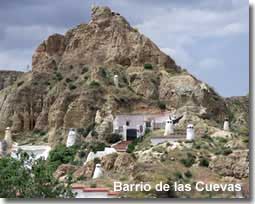 modernised, with running water, electricity and domestic appliances of the latest convenience, many of these residences having been extended outwards with extra rooms and terraces. Yet further into the barrio, the only evidence of the more simply designed dwellings are the whitewashed doors, windows, and chimneys scattered along the hillsides. The bizarre landscape, offering an insight into times gone by, is also littered with ancient and abandoned cave entrances.
modernised, with running water, electricity and domestic appliances of the latest convenience, many of these residences having been extended outwards with extra rooms and terraces. Yet further into the barrio, the only evidence of the more simply designed dwellings are the whitewashed doors, windows, and chimneys scattered along the hillsides. The bizarre landscape, offering an insight into times gone by, is also littered with ancient and abandoned cave entrances.
It is possible to drive around the main part of the neighbourhood, but a little wander on foot is worth the effort. I found the people of cave community of Guadix to be very welcoming and extremely cave proud.
On my visit there, while quizzing one of the helpful locals, Jose, for information, in my rather basic Spanish I might add, I was invited to view and photograph the inside of his cave home, 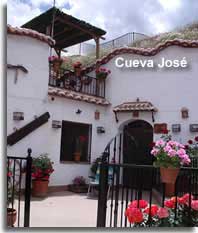 how could I refuse such an opportunity!
how could I refuse such an opportunity!
Cueva Jose had a very lovely outside terrace and seating area, inside the rooms were just like any normal house and fully equipped with wide screen TV, cooker, fridge, etc... Traditional Spanish costumes had been hung up on show in the main bedroom, a touch no doubt intended to impress his visitors, 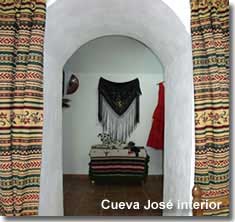 which I thought was quite sweet, Jose was a man proud of both his home and his culture. After a tour of all the rooms Jose directed me to a viewing point on the terrain above his cave from where I had fantastic views of the whole town and far beyond to the Nevada mountains.
which I thought was quite sweet, Jose was a man proud of both his home and his culture. After a tour of all the rooms Jose directed me to a viewing point on the terrain above his cave from where I had fantastic views of the whole town and far beyond to the Nevada mountains.
I must mention that Jose, along with many of the friendly people of the barrio, has his own little tourist business going on, of which I was fully aware and more than happy to go along with. 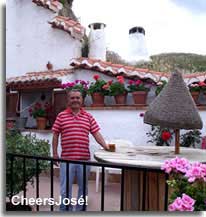 During the tour of his cave it would have been hard not to notice the selection of trinkets that were displayed for sale in the entrance hall and the gratuity dish for tips beside the front door.
During the tour of his cave it would have been hard not to notice the selection of trinkets that were displayed for sale in the entrance hall and the gratuity dish for tips beside the front door.
Excited by the chance to see inside a real cave home, and to practise my Spanish, this was most definitely a few euros well spent.
Cueva Jose is situated close to the Plaza del Padre Poveda, his terrace, overlooking the square, is in a prime spot to welcome passing tourist.
Later, as I was leaving the plaza, I looked over to Joses house and smiled to myself as I saw him welcome two more curious guests into his home.
Plaza del Padre Poveda,  is located at the heart of the old quarter and named after one of its former residents, Father Pedro Poveda. The square is found by following the signs to Cueva Museo and Barrio de las Cuevas.
is located at the heart of the old quarter and named after one of its former residents, Father Pedro Poveda. The square is found by following the signs to Cueva Museo and Barrio de las Cuevas.
The story of Padre Poveda
He was born Pedro Poveda in the province of Jaen in 1874. A boy with compassion and vision, who, even in his early years became aware of the difficulties endured in the lives of the people around him, already a desire for improvement forming in his young mind. 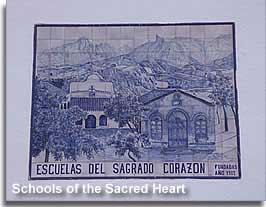 Entering the priesthood at a very early age and gaining scholarship at the seminar of Guadix, he was ordained a priest in 1897 at the age of twenty three. On witnessing the impoverishment of the timid, uneducated and outcast community of the cave dwellers in Guadix his Christian ethics and aspirations of betterment for the people could not be denied, thus he dedicated his time there to teaching and helping the poor gypsy families, creating sensitivity to their plight among the residents of the city. His involvement became so deep that he moved into the community and made his home in one of the caves. For the children of the caves, who he grew to love as his own family, he helped to set up the
Entering the priesthood at a very early age and gaining scholarship at the seminar of Guadix, he was ordained a priest in 1897 at the age of twenty three. On witnessing the impoverishment of the timid, uneducated and outcast community of the cave dwellers in Guadix his Christian ethics and aspirations of betterment for the people could not be denied, thus he dedicated his time there to teaching and helping the poor gypsy families, creating sensitivity to their plight among the residents of the city. His involvement became so deep that he moved into the community and made his home in one of the caves. For the children of the caves, who he grew to love as his own family, he helped to set up the 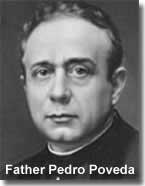 Escuelas del Sagrado Corazon educational facilities, the Schools of the Sacred Heart. It is suggested that his religious teachings, perhaps a little advanced for the times, were not easily accepted and played a large part in his decision to leave Guadix. Following his departure he continued with his pioneering Christian work and eventually went on to found the Teresian Association, now international, this association engages in worldwide educational and humanitarian endeavours.
Escuelas del Sagrado Corazon educational facilities, the Schools of the Sacred Heart. It is suggested that his religious teachings, perhaps a little advanced for the times, were not easily accepted and played a large part in his decision to leave Guadix. Following his departure he continued with his pioneering Christian work and eventually went on to found the Teresian Association, now international, this association engages in worldwide educational and humanitarian endeavours.
When the Civil War broke out in Spain, Pedro Poveda was identified as an enemy for his faith and for the cause of Christian education.
On July 28, 1936, he was shot to death by firing squad.
The 4th May 2003 marked his canonization by Pope John Paul II in Madrid. Pedro Poveda was declared a Saint. 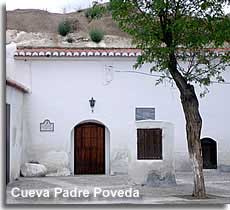
His work lives on and continues to help people all around the world, and he will never be forgotten by the Guadix cave community.
Today, Father Povedas cave, Cueva de Padre Poveda, can still be seen on a visit to the plaza, which is also home to the Ermita Nueva chapel, and the Cueva Museo. The cave museum offers an insight into history and lifestyle of the troglodyte cave dwellers. On the edge of the square is the modern school Colegio de Padre Poveda, and the Centro Sociocultural Pedro Poveda, the areas adult educational facility offering classes in reading and writing, cooking, painting and 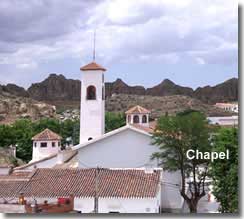 dance among others. To the right of these buildings is the eating establishment and bar of Meson Cueva Virgen de Gracia, named after the Virgin of Grace, the patrona of the district, the cave has an outside terrace for refreshments.
dance among others. To the right of these buildings is the eating establishment and bar of Meson Cueva Virgen de Gracia, named after the Virgin of Grace, the patrona of the district, the cave has an outside terrace for refreshments.
On my visit to Plaza del Padre Poveda, in the spring of 2011, I was extremely disappointed to find that the chapel, the museum and Father Pedros Cave were all closed as the plaza was under restoration, while this is a good thing my timing could have been better. I was also looking forward to seeing the statue of the Virgin of Grace, which I believe to be inside the Ermita Nueva chapel.
I would like to plead  within anyone who takes this highly recommended visit, after the restoration works have been completed, to send me some photos, particularly of the internal areas of Padre Povedas cave, the reformed cave museum and the chapel, including the statue of the Virgen de Gracia, so that I may add them to these pages for myself and others to appreciate.
within anyone who takes this highly recommended visit, after the restoration works have been completed, to send me some photos, particularly of the internal areas of Padre Povedas cave, the reformed cave museum and the chapel, including the statue of the Virgen de Gracia, so that I may add them to these pages for myself and others to appreciate.
It has to be said though, after I explained to the local shop keeper that I had travelled a couple of hours to see and photograph the inside of Father Pedros Cave, she was more than understanding and extremely helpful and sent me off in the direction of the Centro Sociocultural where there was a possibility of finding the cave key holder, again my luck was out, nobody was in!
The restoration work on the Plaza was expected to be completed by the end of 2011, according to Jose.
External links
Provided to help visitors make the most of the area. The links will open in a separate page.
For further information on the life and work of Pedro Poveda visit www.pedropoveda.org







